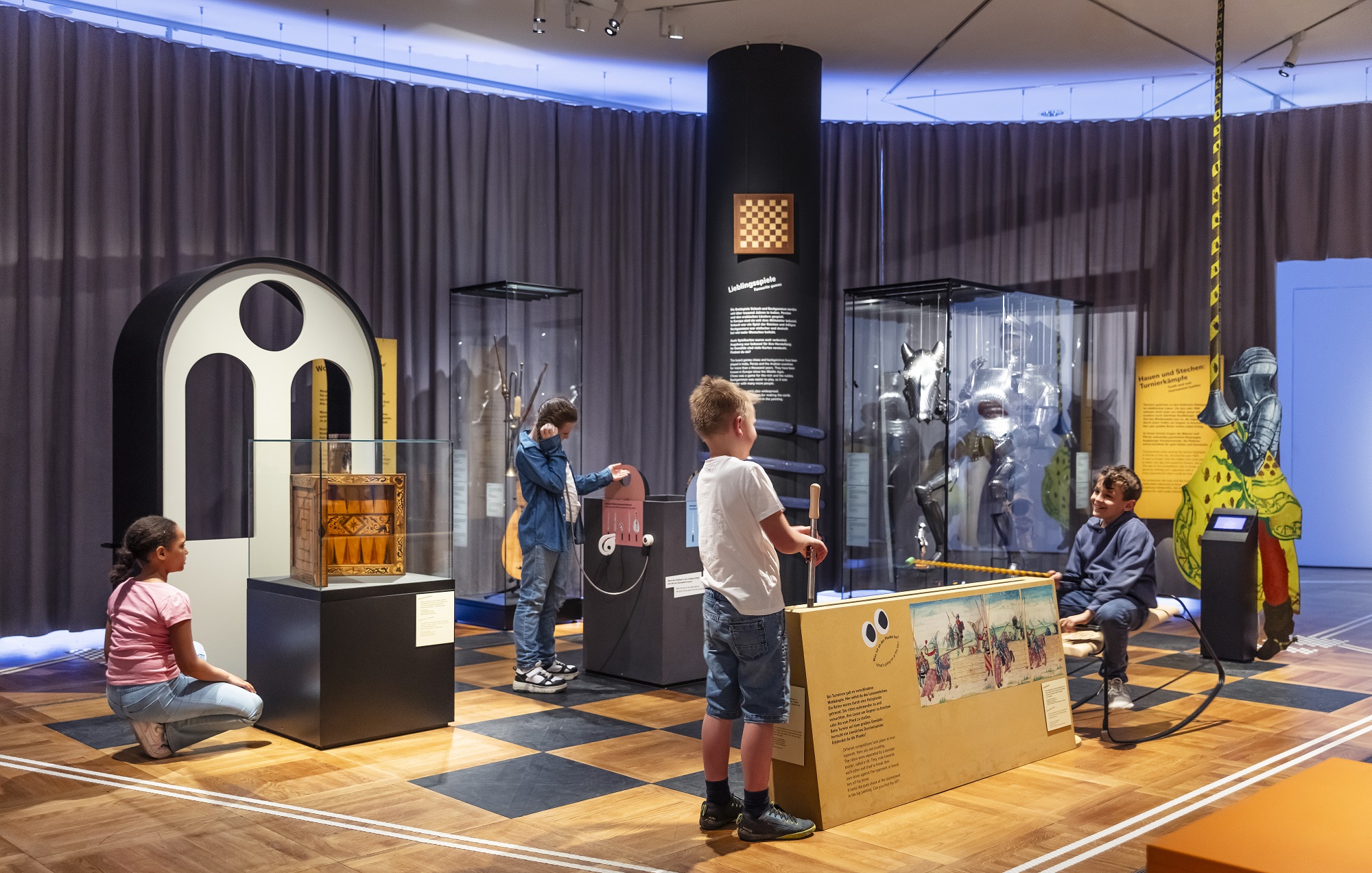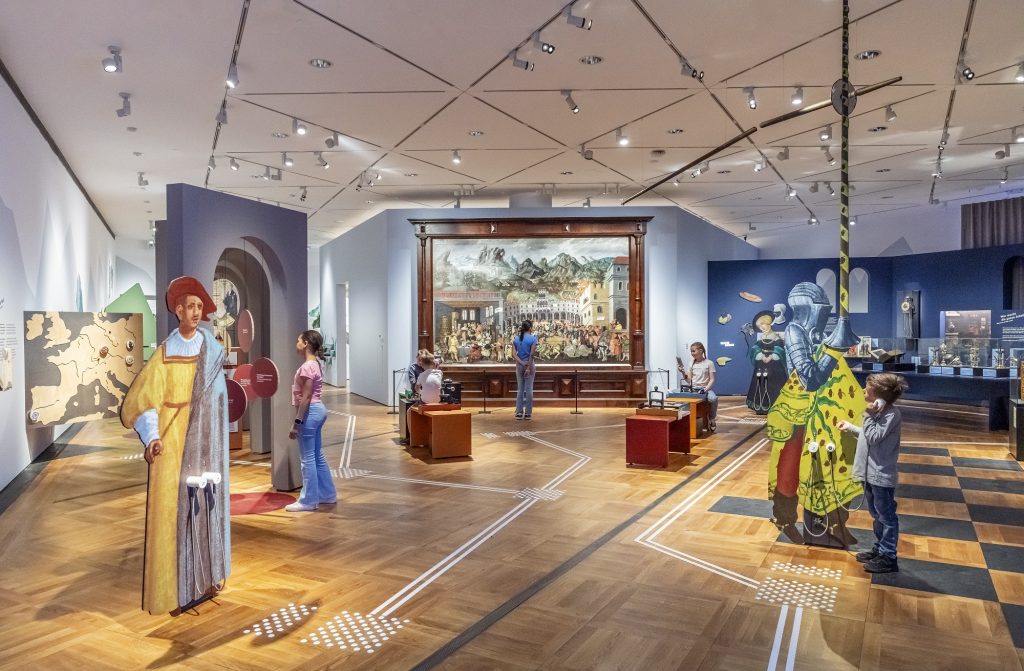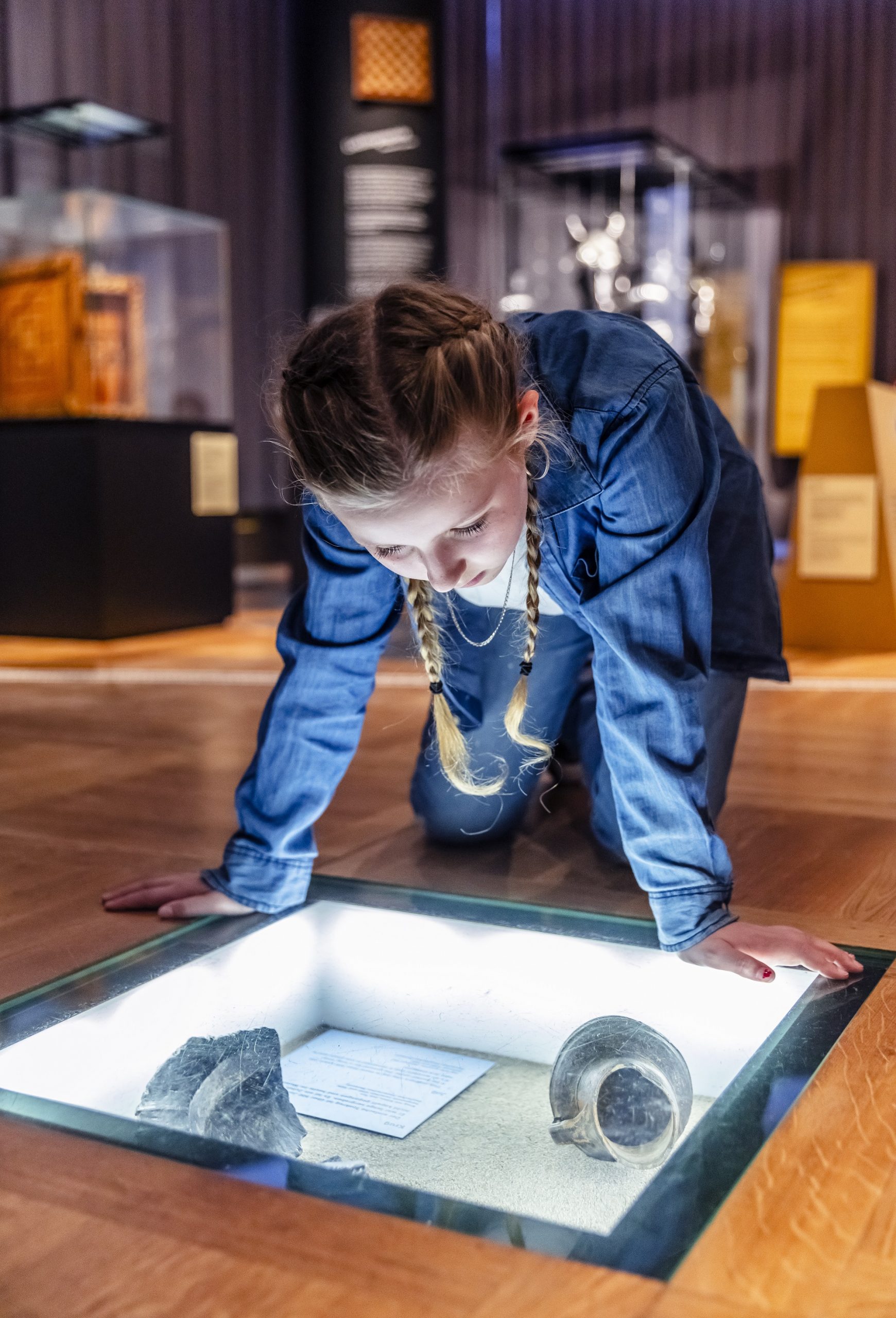
From Idea to Realisation – Interview with Anna-Jelena Schilling and Tom Gärtner
22 January 2025
With the exhibition “Dive into the Picture! Time Travel for Kids” the Deutsches Historisches Museum showed for the first time, from 2 June 2024 to 19 January 2025, an inclusively designed exhibition for children of grade school age. It was based on the Picture of the Month “January – February – March”, which belongs to the famous seasonal cycle of the so-called “Augsburg Pictures of the Months” from the 16th century, one of the most important artworks in the DHM collections. Here the world of 500 years ago unfolds before us as if we were in a 3-D walk-in backdrop.
In our interview series we talk with the people and teams that have made this exhibition possible through their ideas and expertise. In this interview, we spoke with Anna-Jelena Schilling, project assistant, and Tom Gärtner, student assistant, about the evaluation of the exhibition.
What role does the evaluation of the exhibition “Dive into the Picture! Time Travel for Kids” play?
Anna-Jelena Schilling: “Dive into the Picture! Time Travel for Kids” was the first children’s exhibition in the Deutsches Historisches Museum. So it was not only one of the countless special temporary exhibitions, but stood for the conscious approach to a new target group that has its own needs and wishes. “Dive into the Picture!” therefore was designed to serve as a kind of “rehearsal stage” for the future area in the Zeughaus that will be devoted to children and families. For the project team of the new Permanent Exhibition it was obvious that they could learn not only from the exhibition itself, but also from the new group of visitors. The fact that a great many children came to the DHM to see the exhibition and evidently felt very much at home was important, but was not enough to summarise what the exhibition meant. We wanted to better understand the new target group and in this way further develop our approaches that had proved successful. A sound evaluation was to serve as the basis for this undertaking. Not least of all, we see our task as an effort to show our appreciation early on to the new target group as the ”visitors from tomorrow” and to take away as much as possible from these experiences and utilise it for the development of the new area in the Zeughaus.

How did you gather and evaluate the feedback about the exhibition from the visitors?
Tom Gärtner: In order to find out what effect the exhibition had on the children and people who accompanied them, we used many different approaches on how to study audience reactions. For example, we observed how long children stayed at the stations and which objects or games were especially attractive to them. Through talks with both the younger and older visitors, we got their impressions directly: Which figures or stories stayed in their minds? What did they enjoy most of all and what could we have done better? We also analysed the use of accompanying materials they could take home with them, like the puzzle folder, in order to understand which devices were good or less effective.
We gathered the feedback through behind the scenes observation and direct conversations. We documented how the children and their accompaniers interacted with the stations and which elements were particularly appealing. In the talks the children described their impressions and criticised elements that were less appealing.
All the data we have collected will be analysed in the end in order to recognise patterns and preferences. This shows which things are particularly captivating and where there are barriers. The evaluation helps to review the mediation aims of the exhibition and to find a balance between playful experience and the communication of knowledge.

What observations and answers surprised you?
Tom Gärtner: The audio stations turned out to be the absolute highlights. Children often listened to the stories with rapt attention and later retained an astonishing amount of detail. Interactive elements such as the lance station were also favourites – everything that can be touched, tested and formed attracts their attention. Particularly exciting: children influence each other. Enthusiastic cries like “That’s the best station!” soon meant that a little cluster of kids would form around the favourite areas.
Adults are more than mere accompaniment. They read aloud, explain the contents, and help to facilitate access to the more complicated information. This clearly shows that while children concentrate completely on playing and experiencing, adults pay more attention to pedagogical aspects and think about the learning effect of the exhibition. We were pleased to observe that lively discussions between the visitors developed and the exhibition became a joint experience.
It was also interesting that certain stagings attracted attention in a very special way. Whether it was the crown glass pane or the unrestored painting – such elements have a certain appeal and stick in the mind. Play stations that are directly linked to the historical background also encourage understanding and enthusiasm.
Exercises that are easy to understand help to communicate information in a lasting way. Children love it when they discover history in a playful way, and when they actively participate, they are better able to remember what they have learned. This also came out in the evaluation of the interviews.
The findings we have gathered show that interactive elements and those experienced through the senses are the key to a successful mediation process. But equally important is the role played by the accompanying persons, who support the children and create relationships to more complex topics. These insights from the study of the visitors helped to further develop the exhibition – for an experience that is entertaining, instructive and inspiring.

Which findings from the evaluation will play an important role in the planned children’s and family area in the Zeughaus and which ones should be adopted?
Anna-Jelena Schilling: Naturally, as much of our findings from the past children’s exhibition as possible should flow into the development of the future children’s and family area. At the moment we are still in the phase of finding the topics for the new area, so that what can be transferred to the plans for the Zeughaus depends largely on that. In any case, very much can be derived from the concept of “Dive into the Picture!”, which we hope to further develop on the basis of the evaluation.
Similar to the section we set up in front of the painting from the cycle of the “Augsburg Pictures of the Months”, it seems sensible to create an information area for groups where the people can find orientation about the rest of the exhibition. This area should be big enough and contain enough information to provide such an introduction. Depending on the varying behaviour of the visitors, the architecture of the exhibition should take account of the sound that is created. In the same way, it is important in the exhibition and its infrastructure to reflect the heterogeneity of the small family groups with their different needs and requirements. For example, it turns out that it is especially important to have a great number of seating arrangements and places of retreat in a children’s exhibition.
The DHM’s concept to use historical objects from our collection as the basis for a children’s exhibition has been confirmed in many ways and has also been firmly endorsed by our review board after many tours. On the other hand, since the object texts that we normally write for our exhibitions do not play an important role for children, it is necessary to integrate the objects into a pattern of creative storytelling for the young, enthusiastic visitors. This allows the children to learn about history in a playful way.